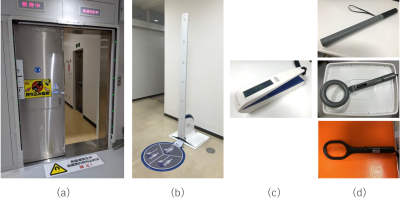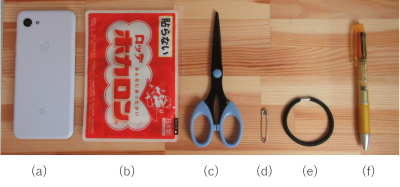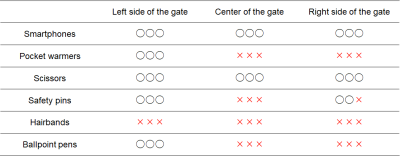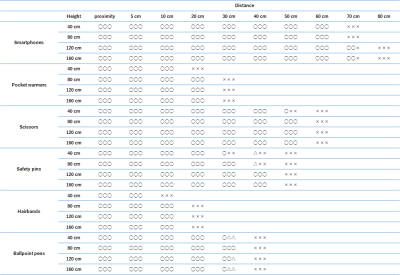5070
Evaluation of the characteristics of magnetic detectors and metal detectors for MRI examinations1Radiological Technology, Gunma Prefectural College of Health Sciences, Maebashi, Japan, 2Radiological Technology, Nagoya University Hospital, Nagoya, Japan, 3Diagnostic imaging, Institute of Brain and Blood Vessels Mihara Memorial Hospital, Isesaki, Japan, 4Imaging Center, St. Marianna University School of Medicine Hospital, Kawasaki, Japan, 5Radiological Technology, Tokyo Women's Medical University Hospital, Shinjuku, Japan
Synopsis
The purpose of this study is to evaluate magnetic detectors and metal detectors to understand their performance and characteristics. The measurement objects were smartphones, disposable pocket warmers, scissors, ballpoint pens, safety pins, and hair bands with rings. The detection performance of each object was examined at several facilities using a gate-type, a pole-type and, a handheld-type magnetic detectors and a handheld-type metal detector. There were differences in detectability depending on the size and type of magnetic material. The sensitivity range and objects that are easy to detect may also differ depending on the type of detector.
Background
The question surrounding the detection of ferromagnetic implants, devices, and foreign bodies is a current research topic with growing international interest(1-5). Many facilities have magnetic detectors and metal detectors to prevent magnetic materials from bringing MRI examination rooms. Conventional metal detectors “alarm” on all metals, ferromagnetic and non-ferromagnetic, and, therefore, may detect many objects that can be legitimately taken into the MR system room which do not pose a missile-related hazard. A ferromagnetic detector selectively detects ferromagnetic objects, ignoring non-ferromagnetic objects. Because only ferromagnetic objects pose a missile-related hazard, a ferromagnetic detector selectively detects threats and works by monitoring the ambient magnetic field using magnetic sensors. However, there are various types of these detectors, and their performance and characteristics are different. Therefore, the purpose of this study is to evaluate multiple types of magnetic detectors and metal detectors in various facilities in line with the actual operation and to understand their performance and characteristics.Methods
The measurement objects were smartphones, disposable pocket warmers (unopened), scissors, ballpoint pens, safety pins, and hair bands with rings. The detection performance of each object was examined at several facilities using a gate-type ferromagnetic detector, a pole-type magnetic detector, a handheld-type magnetic detector, and a handheld-type metal detector. For the gate-type, the detector was tested by holding an object and passing through the gate. For the pole-type, the detectability was measured at each position by varying the height and distance. In addition, we tested the detectability of the pole-type by holding an object and rotating it, assuming actual operation. In the case of the handheld type, each device was fixed on a stand, and the detectability was measured by changing the distance of the object. In addition, we measured the detectability of the handheld type by holding the object in a standing position, on a stretcher, and in a wheelchair, assuming actual operation.Results
The gate-type detected the smartphone and scissors, but not the other objects. In the pole-type, the smartphone, scissors, and safety pin were detected at a relatively long distance, but the pocket warmer and hairband were detected at a short distance and were difficult to detect in the rotation test. In addition, the detection distance became shorter at a lower position. In the handy-type, the magnetic detector had a higher detection sensitivity for the safety pin, and the metal detector had a higher detection performance for the pocket warmer. Ballpoint pens and hair bands were difficult to be detected by both devices in the actual operation test.Conclusions
There were differences in detectability depending on the size and type of magnetic material. The sensitivity range and objects that are easy to detect may also differ depending on the type of detector. When checking metals before entering an MRI examination room, it is important to understand the characteristics of each device and use it according to the purpose.Acknowledgements
We gratefully acknowledge the support of a Japanese Society of Radiological Technology (JSRT) research grant (2020 and 2021).References
1. Boutin RD, Briggs JE, Williamson MR. Injuries associated with MR imaging: survey of safety records and methods used to screen patients for metallic foreign bodies before imaging. AJR Am J Roentgenol 1994;162(1):189-194.
2. Shellock FG, Karacozoff AM. Detection of implants and other objects using a ferromagnetic detection system: implications for patient screening before MRI. AJR Am J Roentgenol 2013;201(4):720-725.
3. Orchard LJ. Implementation of a ferromagnetic detection system in a clinical MRI setting. Radiography 2015;21(3):248-253.
4. Otjen JP, Mallon K, Brown JC. Acupressure magnets: a possible MRI hazard. J Magn Reson Imaging 2015;41(3):858-860.
5. Gianesin B, Zefiro D, Paparo F, et al. Characterization of ferromagnetic or conductive properties of metallic foreign objects embedded within the human body with magnetic iron detector (MID): Screening patients for MRI. Magn Reson Med 2015;73(5):2030-2037.
Figures




